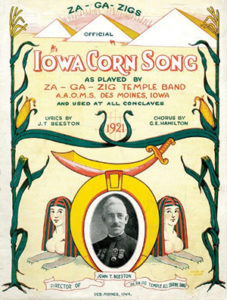Above: Elevating the caliber of pro baseball in the city was a cracker-jack idea from the Chamber of Commerce.
Writer: David Elbert
The Association of Chamber of Commerce Executives is bringing more than 1,000 men and women from across the country to Des Moines for its 104th annual meeting, July 17-20. The attendees are experts at working behind the scenes, and we’d like to honor them by sharing some seldom-told stories about how our own chamber members made a difference.
Busting Borders
Let’s start with the city. The Des Moines we know today is a hybrid of the original 1851 city and seven suburbs that merged in 1890, when the Iowa Legislature extended Des Moines’ city limits 2 1/2 miles in all directions. This enlarged our hometown from 8 square miles to 54 square miles, a nearly sixfold increase. The expansion plan was hatched in 1888 by the same people who had earlier that year created the Des Moines Commercial Exchange (later renamed the Chamber of Commerce). The municipal merger was challenged in court, and the Iowa Supreme Court ruled in 1896 that the enabling act was “special interest” legislation and therefore illegal. But, the justices added, unwinding the merger would cause even more problems, so they let it stand.
Electric Car
In 1889, three years after the Iowa State Fair had acquired a permanent site in Des Moines, leaders of the Commercial Exchange sought to boost fair attendance by creating a local festival similar to Mardi Gras. Seni Om Sed (Des Moines spelled backward) featured exotic themes, including a “Last Days of Pompeii” fireworks display in 1893. The most unusual entrant in the first Seni Om Sed parade was a battery-powered vehicle, which its inventor, Des Moines chemist William Morrison, claimed was the world’s first electric car. His four-horsepower carriage had three broad seats and could carry up to 12 passengers at a top speed of 20 miles an hour for up to 13 hours.
 Corn Song
Corn Song
Des Moines’ Convention and Visitors Bureau was created as an arm of the Chamber of Commerce in 1908. By then the city was already well known on the national convention circuit, in part because it had been one of the first to install electric streetlights during the 1880s. Another piece of Des Moines convention trivia: George E. Hamilton, who headed the Convention Bureau for 24 years, composed “The Iowa Corn Song” during a 1912 train trip to a Shriners convention in Los Angeles. Hamilton “wanted a rousing, peppy tune for the Iowa Shriners to sing as they entered the convention hall,” explained Iowa history writer Tom Longden.
Lindy Lands
The first airplane to land near Des Moines did so on the evening of July 1, 1925. It was carrying mail from Chicago, and during the less than 20 minutes it was on the ground a post office band played “The Iowa Corn Song.” Among the 40,000 greeters were the top officers of the Des Moines Chamber of Commerce, who had been instrumental in bringing airmail to Des Moines. Two years later, those same officials were among 50,000 people who welcomed Charles Lindbergh and his Spirit of St. Louis airplane to Des Moines, just three months after Lindy’s historic solo flight across the Atlantic Ocean. A line of cars that some said was “the longest parade in the history of the state” followed Lindbergh from that early airport near Altoona to the Hotel Fort Des Moines, where he was feted and spent the night.
Play Ball
Professional baseball in Des Moines predates the Des Moines Commercial Exchange, but baseball owes its modern incarnation to chamber executives. Des Moines’ first professional baseball team, the Hawkeyes, was formed in 1887, one year ahead of the Commercial Exchange. Between 1900 and 1924, Des Moines teams had seven different names, including the Midgets, Undertakers, Prohibitionists and Underwriters. After World War II, chamber members restarted baseball in Des Moines by purchasing a franchise in the Western League for $5,000. In 1947, the chamber built a park for the Des Moines Bruins atop a landfill. Seventy years later, that same site is Principal Park, home of the Triple-A Iowa Cubs.
War Efforts
From 1926 until 1962, the top staff person at the Des Moines Chamber of Commerce was John D. Adams, who had the brain of an engineer and the marketing skills of a salesman. Adams’ meticulous attention to details helped persuade federal officials to locate the Iowa Air National Guard in Des Moines during World War II and to repurpose Fort Des Moines as the first military training center for women. He also persuaded San Diego-based Solar Aircraft to convert a Ford auto plant in Des Moines into a parts factory during the war and to convert farmland outside Ankeny to an armaments plant. After the war, Ankeny’s ordnance plant was reconfigured to make John Deere farm implements.
Rolling It Up
Perhaps John D. Adams said it best: “The work of the Chamber is never done. There is no beginning or end as such.” Des Moines’ downtown skywalk system is one of many projects that prove his point. The skywalks began with a single bridge more than 40 years ago. The system now extends for nearly 3 miles, and it is still growing.
The Principal Riverwalk is another effort that started small and continues to grow. The arts community has been another big driver, providing a focus on public art and creating the John and Mary Pappajohn Sculpture Park. And then there’s the Science Center of Iowa, the Greater Des Moines Botanical Garden, Gray’s Lake, East Village, Market District and Court Avenue. As Adams might have observed: They are all now part of one giant seamless fabric we call Des Moines.








